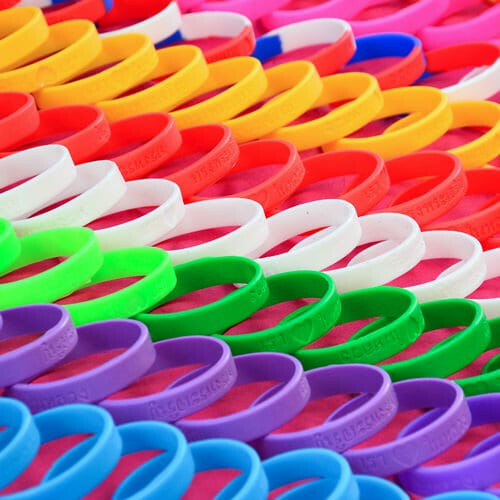
Product Spotlight: Silicone Wristbands
Silicone wristbands are an example of small but mighty. These simple bands are a marketing powerhouse.
Rick Cundiff
How do you make a big difference in brand awareness and marketing? Some would say you need to do something big and splashy. Billboards, flashing lights, broadcast media ads, and a huge presence on social media.
There’s nothing wrong with any of those methods, and indeed a combination of factors are ideal. But don’t forget that small things can make a big difference too. One classic product that can have a big impact from a small size is custom wristbands.
Silicone wristbands and their paper, rubber and Tyvek™ counterparts have had their ups and downs. Still, they’ve earned a lasting place in the pantheon of great promotional products, thanks to a combination of high visibility, great popularity and low cost.
In the Beginning
Bracelets are nothing new. In fact, they’ve been traced as far back as 5000 BCE. They have been used as decorations, and to indicate social position such as the wearer’s marital status.
Many people use the terms bangle and bracelet interchangeably, although there are differences between the two. Bangles are typically metal, in a single closed loop. Bracelets are more wide-ranging in terms of materials, and can be open ended or have a clasp or other closure.
The precursors of modern silicone bracelet wristbands originated in the 1970s. The punk rock scene spawned a rebellion against traditional jewelry. Punk was as much a lifestyle as a music style. Instead of the usual bracelets, punk devotees wore rubber wristbands, typically black. Along with ripped jeans, leather jackets, and safety pin adornments, the wristbands made a militant fashion statement.
By the 1980s, more mainstream artists such as Madonna and Cyndi Lauper began wearing rubber bracelets as well. But it really took an athlete and a cause in the early 2000s to make silicone wristbands mainstream.
2004 – The Classic Livestrong Wristband
Cyclist Lance Armstrong partnered with Nike in 2004 to produce the simple yellow wristband imprinted with the word “Livestrong.” It was made of medical-grade silicone rather than rubber. Sales soared, and an icon was born.
Over the next eight years, the organization known then as the Lance Armstrong Foundation sold millions of the wristbands at just $1 each, raising some $80 million for cancer research and patient support. The success of the yellow band spawned imitators in many colors, often assigning a specific color to a particular medical condition. And they served as effective fundraising tools for those organizations as well. But storm clouds gathered over those years.
In 2013, the storm broke. Armstrong admitted, after denying for years, that he had been illegally doping during his racing career. He was stripped of his seven Tour de France titles, and Nike severed all ties. The Lance Armstrong Foundation changed its name to the Livestrong Foundation, and continues its mission to this day. And they still sell the classic yellow wristband, still for just $1 each.
All told, silicone wristbands have raised hundreds of millions of dollars for worthwhile causes the world over. From disaster relief funds for Haiti earthquake victims and Japanese earthquake/tsunami survivors to school programs, the simple little silicone bands have helped raise both cash and awareness.
What Makes Them So Popular?
A combination of factors make wristbands appealing. To start, they’re colorful. They add a splash of color and carefree style to just about any outfit, from jeans to black tie. With a variety of sizes and styles available, they’re suitable for just about any occasion.
Wristbands also are an easy way to contribute to a cause. People like to feel like they’re doing something for a worthy cause, even if it’s just a small gesture. Buying and wearing a colorful wristband lets the wearer feel they’re contributing to something meaningful to them. And they are. Every sale counts toward a benefit for the cause.
The main driving factor behind wristbands’ runaway success, however, is their low cost. Bought for pennies apiece in bulk, they can be sold for dollars each. Their high profitability allows school groups and others to raise significant amounts of cash quickly.
They may not be the most obvious marketing devices, but custom silicone wristbands are an easy way to promote a cause, raise funds for a program or event, and make a difference in the world.
Rick Cundiff
Content Director, Blogger
Rick Cundiff spent 15 years as a newspaper journalist before joining TJM Promos. He has been researching and writing about promotional products for more than 10 years. He believes in the Oxford comma, eradicating the word "utilize," and Santa Claus.
